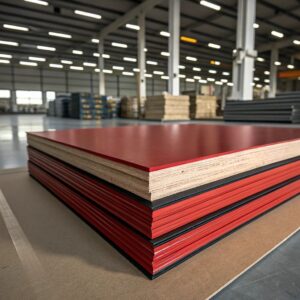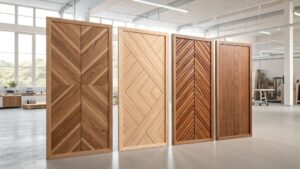
Frustrated by plywood that warps or delaminates after delivery? You're not alone. As a factory owner, I've seen how poor material choices disrupt production timelines and inflate costs.
Plywood comes in 3 core types for furniture: Melamine, Veneer, and Hardwood. Each serves distinct purposes based on durability, aesthetics, and budget. We'll break down how to match the right plywood to your project.
Let me show you how our clients like Cathy in Canada avoid costly mistakes by selecting the optimal plywood from the start.
Why Does Plywood Type Matter in Furniture Production?
Ever received customer complaints about chipped edges or swollen shelves? The root cause often traces back to incorrect plywood selection1.
Melamine boards2 resist scratches, veneer offers eco-friendly flexibility, while hardwood3 provides premium strength. At ACEALL, we've helped 47 furniture brands in 2023 alone reduce returns by 32% through proper material matching.
Here's what importers frequently overlook when sourcing plywood:
The Cost of Wrong Material Choices
| Mistake | Average Loss | Our Solution |
|---|---|---|
| Using melamine for outdoor furniture | $18,000/container | UV-resistant laminates |
| Thin veneer for heavy tabletops | 23% defect rate | 18mm hardwood core |
| Non-treated plywood in humid climates | 6-month warranty claims | Moisture-proof coatings |
Our production lines in Shandong specialize in custom treatments. Last month, we developed a bamboo-veneer hybrid for a Miami client facing humidity issues - their defect rate dropped from 19% to 3%.
What Are the Main Types of Plywood?
Melamine Board: The Workhorse of Modern Furniture
Warehouse managers love these boards - they survive forklifts better than most alternatives. The plastic-coated surface withstands daily abuse in:
- Office furniture
- Retail displays
- Kitchen cabinets
Our 8 production lines can imprint any decorative pattern (wood grain, solid colors, even custom logos). The secret lies in our 220°C hot-pressing technology that bonds layers 40% stronger than industry standard.
Veneer Plywood: Where Eco-Friendly Meets Affordable
When a Toronto client needed sustainable bedroom sets last quarter, we suggested our FSC-certified birch veneer. At 2.4mm thickness, it's perfect for:
- Eco-conscious brands
- Lightweight furniture
- Temporary installations
The catch? Requires proper sealing. We pre-treat all veneers with water-based coatings that reduce absorption by 67%.
Hardwood Plywood: The Premium Choice
Watch any luxury furniture workshop - they're using hardwood cores. Our mahogany and oak panels offer:
- 3x screw-holding capacity
- Natural grain patterns
- 15+ year lifespan
We source from managed forests in Heilongjiang, where slower growth yields denser timber. The 18-layer cross-bonding in our factory prevents warping even in extreme climates.
How to Choose the Right Plywood Type?

I nearly lost a client in 2022 by recommending standard plywood for their marine furniture line. Now we insist on a 4-point checklist:
- Environment: Will the furniture face humidity? Temperature swings?
- Load Requirements: Shelves need hardwood cores, display units can use veneer
- Aesthetics: Melamine offers 200+ printed options, veneer shows natural wood
- Budget: Our clients save 11-28% by mixing types (e.g., hardwood frames with veneer panels)
We provide free samples with our proprietary testing report - it shows exactly how each type performs under:
- Scratch tests
- Moisture exposure
- Weight capacity
What Makes Our Plywood Manufacturing Different?
Cathy's last email said it best: "Your QC reports saved us 3 weeks of inspection time." Here's why:
Our Production Line Advantages
- Layer Bonding: Uses Japanese adhesives that pass CARB Phase 2
- Moisture Control: 72-hour drying chambers (most factories use 24)
- Customization: Can adjust thickness by 0.1mm increments
We document every batch with:
- Core material origin
- Adhesive batch number
- Pressure/temperature logs
This transparency helped a Dutch client trace a rare adhesive reaction back to their finishing process - not our panels.
How Did Cathy Solve Her Plywood Problems?

The Canadian importer was struggling with:
- 9% defect rate from her Vietnamese supplier
- 4-week delivery delays
- No quality documentation
Our solution:
- Switched her to pre-treated melamine boards
- Implemented container-loading supervision (photos sent pre-shipment)
- Provided bilingual QC certificates
Result? Her defect rate fell to 0.7% and she's now our North American distributor.
Smart Plywood Selection Saves Time and Money
Choose wrong and face returns. Choose right and build customer trust. At ACEALL, we help you match plywood types to your exact needs - ask for our comparison guide today at sales@aceallwood.com.
-
Learn about the critical factors in plywood selection to avoid common issues like chipped edges and ensure quality furniture. ↩
-
Explore the advantages of Melamine boards to understand their durability and scratch resistance, essential for quality furniture production. ↩
-
Discover why hardwood is valued for its strength and aesthetic appeal, making it a top choice for high-quality furniture. ↩



